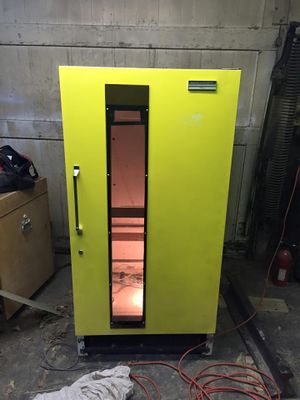Difference between revisions of "Incubation"
(→Bulbs as heating element) |
|||
| Line 1: | Line 1: | ||
| − | [[Image:HenMulator.jpg|thumb|Jacob Springs and Agronomo's prototype '''Henmulator''' arduino controlled incubator]] | + | [[Image:HenMulator.jpg|thumb|[[Jacob Springs]] and [[Agronomo]]'s prototype '''[[Henmulator]]''' [[arduino]] controlled incubator]] |
Revision as of 11:19, 7 February 2015
Incubation is the process of creating an artificial environment for hatching eggs, usually of birds of various species, primarily chickens, ducks, turkeys and geese.
Contents
Design of incubation systems
Heating element
Keeping the incubator warm enough for chicks can be accomplished through a variety of heating methods. Early incubators employed a kerosene wicked lamp with a bi-metallic strip thermostat that adjusted the height of the flame. Today's heating elements can be a variety of types. Perhaps the simplest of which is the use of common incandescent light bulbs and their fixtures.
Redundancy
It's important to build an incubator with a high degree of reliability in order to protect the lives of the unborn animals that are being hatched. With light-bulb heating, this is accomplished through redundancy, in other words, if a bulb were to burn out, there should be enough heating power (wattage) in the bulbs that remain to maintain the proper incubator temperature. This means that at least two bulbs should be used.
Bulbs as heating element
Bulbs in series
With two bulbs connected in series the voltage (and therefore the wattage) of each bulb is cut in half. This dramatically reduces the color temperature of the bulbs increasing the proportion of the energy released as heat and decreasing the amount of visible light given off. The second effect of this decrease in wattage is a dramatic increase in the life of the bulb, causing the filament of the bulb to last over ten times as long as it would under the normal voltage.
The drawback of bulbs in series is that if one bulb burns out, both will go out since the current flows through both filaments.
For incubators that will be used frequently, one recommended strategy to get the most out of lightbulbs used as heating elements is to connect bulbs in a minimum of two sets of two bulbs. Within each set of two bulbs, the two bulb are connected to the other in series rather than the typical parallel arraignment. The two sets are then connected to each other in parallel.
The two sets of two bulbs function in parallel so that, increased bulb life, lower color temperature and redundancy are achieved.
This technique is not necessary in small incubators or those that are infrequently used since the extra expense and space required for additional bulbs, wiring and fixtures is not justified by the small increase in efficiency achieved with only infrequent use.
